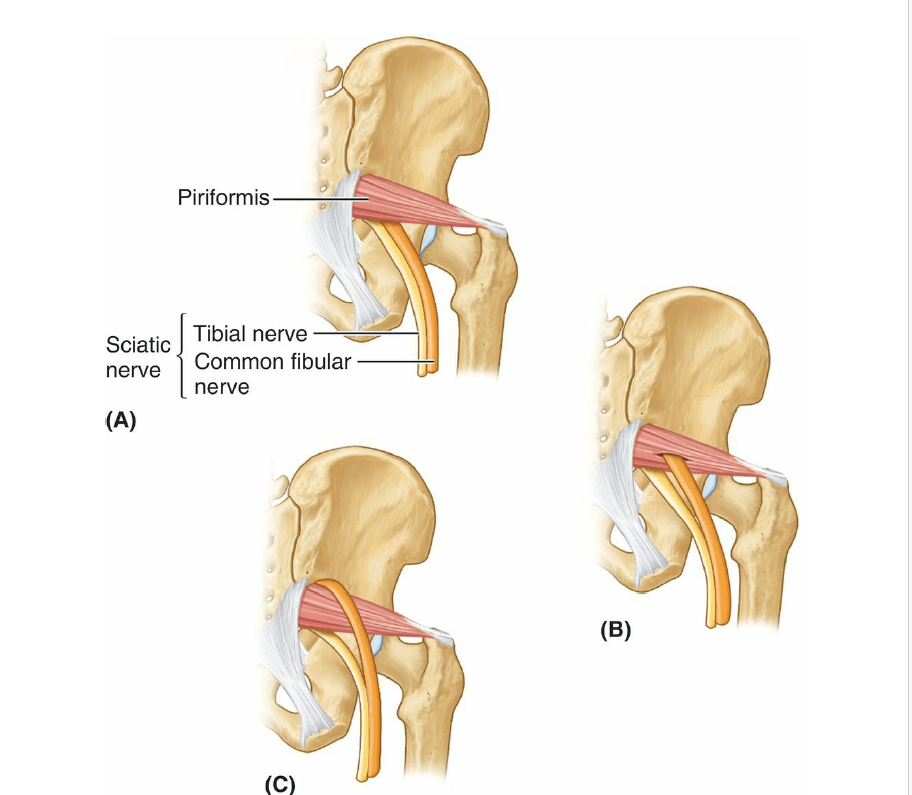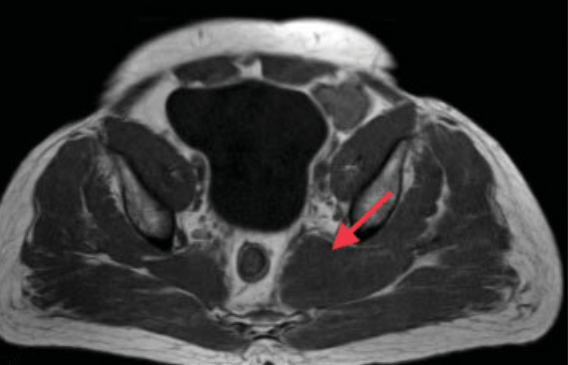Piriformis Syndrome
content of this page
1- Introduction
2- Anatomical Overview
3- Causes
4- Treatment
Introduction
Piriformis syndrome is a neuromuscular condition that occurs when the piriformis muscle, a small muscle located deep in the buttock region, compresses or irritates the sciatic nerve. This can lead to pain, tingling, and numbness in the buttocks and along the path of the sciatic nerve, which runs down the back of the thigh and into the lower leg.

Anatomical Overview
the piriformis muscle, a small, flat, band-like muscle located deep within the buttocks, near the top of the hip joint. The piriformis muscle originates from the anterior surface of the sacrum (the triangular bone at the base of the spine) and inserts into the greater trochanter of the femur (the prominent bony part of the thigh bone). This muscle plays a crucial role in the lateral rotation and stabilization of the hip joint, particularly during activities that involve moving the leg outward and away from the body, such as walking or turning. The sciatic nerve, the longest and largest nerve in the body, usually runs underneath the piriformis muscle, although in some individuals, the nerve may pass through or above the muscle. When the piriformis muscle becomes tight, inflamed, or spasms, it can compress or irritate the sciatic nerve, leading to symptoms of piriformis syndrome. These symptoms include pain, tingling, and numbness in the buttocks and along the path of the sciatic nerve, which extends down the back of the thigh and into the lower leg.

Causes
Muscle Spasms: Spasms in the piriformis muscle, which can be caused by overuse, injury, or prolonged sitting, can put pressure on the sciatic nerve.
Trauma or Injury: Direct trauma to the buttocks or hip, such as from a fall, car accident, or sports injury, can lead to inflammation, scarring, or muscle tightening around the piriformis muscle, which may compress the sciatic nerve.
Overuse and Repetitive Motion: Activities that involve repetitive hip and leg movements, such as running, cycling, or rowing, can cause strain and overuse of the piriformis muscle, leading to inflammation and nerve compression.
Prolonged Sitting: Sitting for long periods, especially on hard surfaces, can cause the piriformis muscle to tighten and press against the sciatic nerve.
Anatomical Variations: In some individuals, the sciatic nerve passes through or above the piriformis muscle rather than beneath it. This anatomical variation can increase the likelihood of nerve compression.
Hip or Back Problems: Issues such as herniated discs, spinal stenosis, or arthritis in the hip joint can alter body mechanics and lead to compensation by the piriformis muscle, resulting in irritation and inflammation.
Postural Imbalances: Poor posture, muscle imbalances, or leg length discrepancies can alter the way the piriformis muscle functions, increasing the risk of irritation and nerve compression.
Inflammatory Conditions: Conditions like sacroiliitis or myofascial pain syndrome can lead to inflammation of the piriformis muscle and surrounding tissues, contributing to nerve irritation.
Treatment
Physical Therapy
- Stretching: Specific stretches targeting the piriformis muscle can help relieve tension and pressure on the sciatic nerve.
- Strengthening Exercises: Strengthening the muscles around the hip and pelvis can improve stability and reduce strain on the piriformis muscle.
- Manual Therapy: Techniques such as massage and myofascial release can help reduce muscle tension.
Medications
- NSAIDs: Nonsteroidal anti-inflammatory drugs like ibuprofen can reduce pain and inflammation.
- Muscle Relaxants: These can help alleviate muscle spasms.
- Pain Relievers: Over-the-counter or prescription pain medications can be used to manage pain symptoms.
Injections
- Corticosteroid Injections: These can reduce inflammation and provide significant pain relief.
- Botulinum Toxin (Botox) Injections: These injections can help relax the piriformis muscle and reduce nerve compression.
Lifestyle Modifications
- Activity Modification: Avoid activities that exacerbate symptoms, such as prolonged sitting or heavy lifting.
- Ergonomic Adjustments: Using ergonomic chairs and cushions can help reduce strain on the piriformis muscle.
Home Remedies
- Ice and Heat Therapy: Ice can reduce inflammation and numb pain, while heat can relax the muscle and improve blood flow.
- Foam Rolling: Using a foam roller to gently massage the piriformis muscle can help relieve tension.